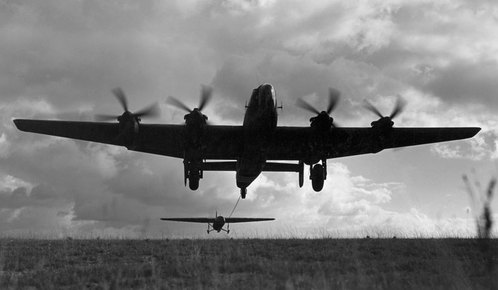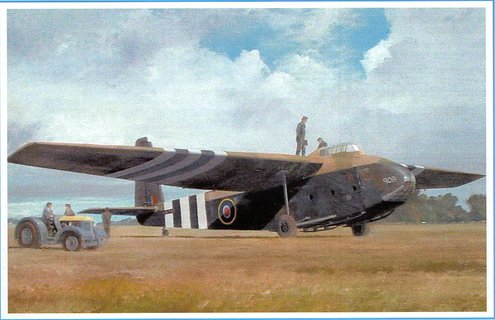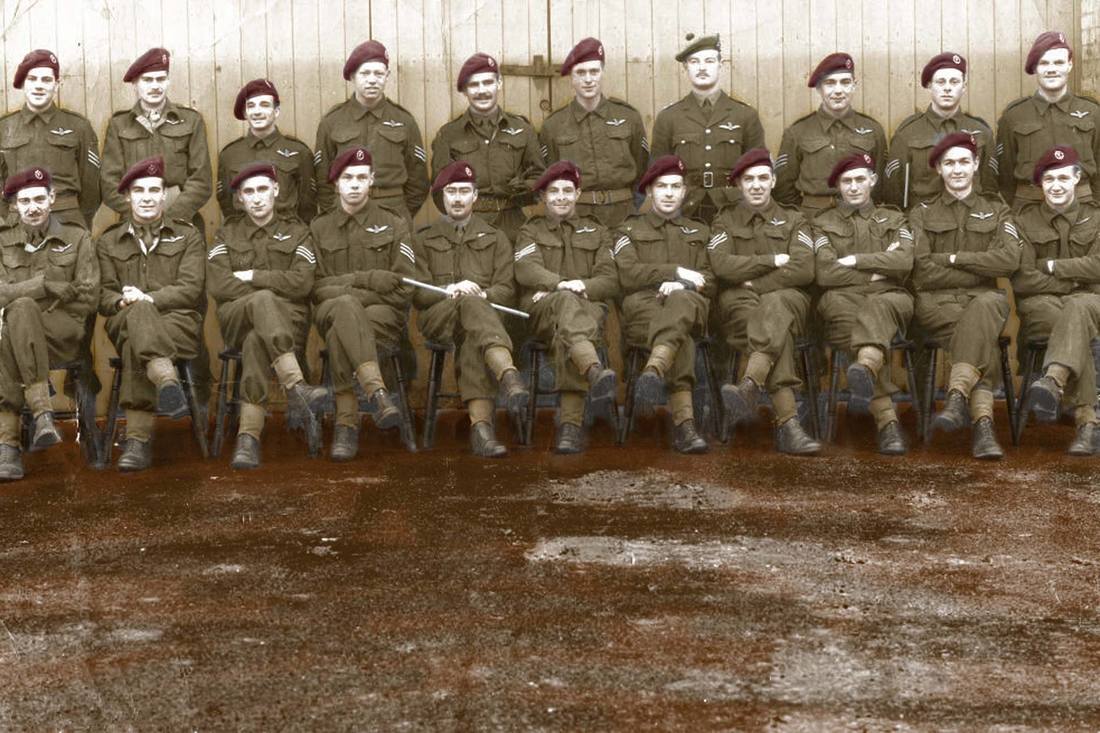THE LOG BOOK STORY
1943
January
Intensive training on the Horsa continued with 27 flights made up to 17 January. The 3 January saw eight flights in a single day.
On 20 January, Aston formally passed out of the 1st Heavy Glider Conversion Unit. His assessment for the course graded him ‘average’.
Lieutenant Aston now had 150 hrs 50 mins of flying experience. From here he would be an active member of the 1st Battalion, The Glider Pilot Regiment.
Intensive training on the Horsa continued with 27 flights made up to 17 January. The 3 January saw eight flights in a single day.
On 20 January, Aston formally passed out of the 1st Heavy Glider Conversion Unit. His assessment for the course graded him ‘average’.
Lieutenant Aston now had 150 hrs 50 mins of flying experience. From here he would be an active member of the 1st Battalion, The Glider Pilot Regiment.
"Training began with dual instruction and when competent solo flying. this usually took about 2 or 3 hours of dual control. It is this training that consisted of circuits and bumps — bump being the landing which was never carried out whilst attached to the Halifax. Firstly the glider was connected to the tug by a length of thick hemp rope. "This was bifurcated just over half way along its length and was attached under each wing. rope contained the intercom wires so that the Halifax pilot and crew could communicate with the glider pilots. The tug would then move slowly to take up the slack and then put all four engines at full power and take off. The glider when fully loaded would be airborne first. The circuit is in fact a rectangle and consists of the climb out, then turn to port still climbing and when about 2000' another turn to port onto the downwind leg, and once past the end of the runway a last turn and now the glider pilot can 'cast off when ready, turn into line with the runway and land."
Words from the Cockpit.
Words from the Cockpit.
 A Halifax bomber acting as a tug for a Horsa glider
A Halifax bomber acting as a tug for a Horsa glider
February – July
Lt. Aston’s logbook shows no flying for this period. After all the intensive training this might appear and extravagant waste of resource. We know he was married to Evelyn Hugill on 16 March 1943 in Doncaster so no doubt some leave was granted.
We also know that during this period, the Glider Pilot Regiment was involved with OPERATION TURKEY BUZZARD, the shipment of gliders to North Africa to enable the landing of artillery and jeeps during the imminent invasion of Sicily. For much of the time, Lt. Aston was the Despatch Officer based at RAF Portreath in north Cornwall, organising the longest glider tows in history.
August
Lt. Aston only spent a single day in the air;2 August. With Sgt. Channell, he flew a loaded Horsa (No DP375) from RAF Hurn, Christchurch, Dorset to Foulsham, about 15 miles NW Norwich, a flight of 1hr 40mins. It seems they unloaded and flew the empty Horsa back to Hurn. RAF Foulsham housed a detachment of Glider storage and maintenance personnel from 12 Glider Maintanance Squadron between April 1943 and March 1944 preparing and maintaining Horsas for the eventual Normandy invasion.
September
With OPERATION LADBROKE, the invasion of Sicily complete Lt. Aston along with Sgts Simpson and Brown on 15 September, piloted Horsa LH130 from Portreath to Salé in NW Africa, a flight that lasted 8hrs 15mins.
After a day’s rest, on 17 September, the three pilots flew to Kairouan in Horsa DP637, a flying time of 6hrs 30mins. Kairouan was a major US base at this time. The following day, 18 September, the erstwhile trio were flown back to Salé, courtesy of the RSAF in a Halifax bomber. It is interesting that the Halifax took longer on the return leg than the glider/tug combination had taken on the way to Kairouan; 7hrs! 20 September saw the trio taking Horsa LH290 from Salé to Kairouan.
For Lt. Aston, it was now a return to England. Over 22-24 September he flew in a Halifax from Kairouan to Port Lyautey, Port Lyautey to Gibraltar and from there back to RAF Hurn.
Lt. Aston’s logbook shows no flying for this period. After all the intensive training this might appear and extravagant waste of resource. We know he was married to Evelyn Hugill on 16 March 1943 in Doncaster so no doubt some leave was granted.
We also know that during this period, the Glider Pilot Regiment was involved with OPERATION TURKEY BUZZARD, the shipment of gliders to North Africa to enable the landing of artillery and jeeps during the imminent invasion of Sicily. For much of the time, Lt. Aston was the Despatch Officer based at RAF Portreath in north Cornwall, organising the longest glider tows in history.
August
Lt. Aston only spent a single day in the air;2 August. With Sgt. Channell, he flew a loaded Horsa (No DP375) from RAF Hurn, Christchurch, Dorset to Foulsham, about 15 miles NW Norwich, a flight of 1hr 40mins. It seems they unloaded and flew the empty Horsa back to Hurn. RAF Foulsham housed a detachment of Glider storage and maintenance personnel from 12 Glider Maintanance Squadron between April 1943 and March 1944 preparing and maintaining Horsas for the eventual Normandy invasion.
September
With OPERATION LADBROKE, the invasion of Sicily complete Lt. Aston along with Sgts Simpson and Brown on 15 September, piloted Horsa LH130 from Portreath to Salé in NW Africa, a flight that lasted 8hrs 15mins.
After a day’s rest, on 17 September, the three pilots flew to Kairouan in Horsa DP637, a flying time of 6hrs 30mins. Kairouan was a major US base at this time. The following day, 18 September, the erstwhile trio were flown back to Salé, courtesy of the RSAF in a Halifax bomber. It is interesting that the Halifax took longer on the return leg than the glider/tug combination had taken on the way to Kairouan; 7hrs! 20 September saw the trio taking Horsa LH290 from Salé to Kairouan.
For Lt. Aston, it was now a return to England. Over 22-24 September he flew in a Halifax from Kairouan to Port Lyautey, Port Lyautey to Gibraltar and from there back to RAF Hurn.
 The GAL Hamilcar glider
The GAL Hamilcar glider
October
On 1 October Lt. Aston flies a Hadrian glider (the American Waco) with S/Sgt Johnson practising circuits for 30 mins. On 3 October he is with Sgt Nielman practising night circuits for 15 mins. 6 October sees him with Sgt. Waring on EXERCISE KAPPA. The log note states they had to return to base due to weather conditions. A total air time of 1 hr 15 mins for October.
November
10 November saw Lt Aston ferrying gliders with Sgt. Sanders between Base and Netheravon. 11 November was an important date. With S/Sgt Johnson as first pilot, Aston took to the air in a GAL Hamilcar glider, a short flight of 15 mins. 18 &19 November was back on a Horsas with Lt. Shuttleworth flying locally 40 mins in total.
25 November saw Aston back in the same Hamilcar (HH992) with Capt. Clark for a circuit lasting 15 mins. The next day was Horsa flying and finally 30 November back in the same Hamilcar for further circuits.
As December will show, it was clear that Lt. Aston had taken to the Hamilcar.
December
2 December saw Lt. Aston go through formal conversion to flying the large GA Hamilcar glider. The last of the three flights that day saw him as 1st pilot for the first time. 3-6 December saw Aston practising a number of circuits, three or four a day. On 10 December he flew the big glider with a half load, a chance to experience the sheer mass of the glider. Whilst 11 December was back to circuits, 30 December was flying cross-country with a full load, a 50 mins flight. If that was not enough, Aston then completed an hour’s night cross-country night flying in a Horsa.
In total, December saw 9hrs 55mins flying with 8hrs 55mins on Hamilcars.
On 1 October Lt. Aston flies a Hadrian glider (the American Waco) with S/Sgt Johnson practising circuits for 30 mins. On 3 October he is with Sgt Nielman practising night circuits for 15 mins. 6 October sees him with Sgt. Waring on EXERCISE KAPPA. The log note states they had to return to base due to weather conditions. A total air time of 1 hr 15 mins for October.
November
10 November saw Lt Aston ferrying gliders with Sgt. Sanders between Base and Netheravon. 11 November was an important date. With S/Sgt Johnson as first pilot, Aston took to the air in a GAL Hamilcar glider, a short flight of 15 mins. 18 &19 November was back on a Horsas with Lt. Shuttleworth flying locally 40 mins in total.
25 November saw Aston back in the same Hamilcar (HH992) with Capt. Clark for a circuit lasting 15 mins. The next day was Horsa flying and finally 30 November back in the same Hamilcar for further circuits.
As December will show, it was clear that Lt. Aston had taken to the Hamilcar.
December
2 December saw Lt. Aston go through formal conversion to flying the large GA Hamilcar glider. The last of the three flights that day saw him as 1st pilot for the first time. 3-6 December saw Aston practising a number of circuits, three or four a day. On 10 December he flew the big glider with a half load, a chance to experience the sheer mass of the glider. Whilst 11 December was back to circuits, 30 December was flying cross-country with a full load, a 50 mins flight. If that was not enough, Aston then completed an hour’s night cross-country night flying in a Horsa.
In total, December saw 9hrs 55mins flying with 8hrs 55mins on Hamilcars.
